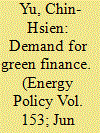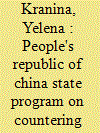|
|
|
Sort Order |
|
|
|
Items / Page
|
|
|
|
|
|
|
| Srl | Item |
| 1 |
ID:
178842


|
|
|
|
|
| Summary/Abstract |
This paper investigates the effects of financing constraints on prompting green innovations using a sample of Chinese listed firms in the period 2001–2017. Also, we explore how green finance policies resolve financing constraints of firms to green innovation. The capability of green innovation is found to be impaired when firms face higher financing constraints, and privately owned enterprises tend to be more vulnerable than state-owned ones in this regard. Although green finance policies can effectively ease financing restraints on green innovation overall, green credits are less likely to be available to privately owned enterprises. However, these enterprises which are deeply affected by financing constraints have relatively high innovation capabilities. We suggest the government to provide more supports to privately owned enterprises for investing in green projects. Further, both financial institutions and privately owned enterprises should be required to disclose more information on green credits and green projects, respectively. In addition, the China Banking Regulatory Commission should design a synthetic mechanism for evaluating green performance.
|
|
|
|
|
|
|
|
|
|
|
|
|
|
|
|
| 2 |
ID:
178836


|
|
|
|
|
| Summary/Abstract |
With the implementation of a series of policies related to the energy conservation and environmental protection (ECEP) industry, green finance has become a crucial approach to provide credits for the ECEP industry. Using data on Chinese-listed ECEP firms from 2010 to 2019, this work quantitatively identifies the financing efficiency of these firms and its determinants. The main results show that banks are still dominant in the Chinese financial market for providing credits, and firms listed on the second board show higher financing efficiency. The financing efficiency of firms located in the central and western regions improves significantly, especially after 2016, reflecting the interaction effect of green finance policies and economic policies supporting underdeveloped regions. Both country-level factors (e.g., formal institutions and financial supervision) and firm-level factors (e.g., firm size and debt ratio) have an impact on financing efficiency. These findings have important implications for policymakers who are carefully contemplating green finance policies to support ECEP firms through an effective financial market mechanism, which eventually helps to realize the transition of the energy sector.
|
|
|
|
|
|
|
|
|
|
|
|
|
|
|
|
| 3 |
ID:
177361


|
|
|
|
|
| Summary/Abstract |
Against the background of climate change, oil-gas-coal companies are particularly concerned by the notion of stranded assets, i.e., the fact that known fossil reserves cannot be burnt should limitations on greenhouse gas emissions become more stringent. Those assets can suffer from unanticipated or premature write-downs, devaluations or conversion to liabilities. This paper simulates the impacts of carbon stranded assets for 17 major oil-gas-coal firms' value until the horizon 2050. The core of the paper is a stochastic model with stopping times that determines by initial conditions (reserves and extraction rates) which companies are left with ‘stranded assets.’ In the business-as-usual scenario, one-quarter of the Earth's capacity for absorbing emissions will be depleted by 2050. With stringent emissions-curbing policies, an environmental gain of 80% can be achieved. Without a restructuring of their business model, many oil-gas-coal companies stand out from our simulations as being particularly vulnerable to the financial risks of bankruptcies and default events.
|
|
|
|
|
|
|
|
|
|
|
|
|
|
|
|
| 4 |
ID:
178841


|
|
|
|
|
| Summary/Abstract |
Maintaining steady economic growth while considering environmental protection and achieving high-efficiency energy utilization is a challenge that China is' increasingly facing in the new normal. This study employs the super-efficiency data envelopment analysis and spatial econometric model to analyze energy utilization efficiency against the backdrop of environmental constraints. It uses China's inter-provincial panel data from 2007 to 2017 to examine the impact of green finance on high-efficiency utilization of energy. China's energy efficiency utilization shows an upward trend overall, but the utilization level is low. Energy efficiency utilization levels in the east, middle, and west show a declining gradient change. Green credit, credit scale, environmental regulation, technological progress, and industrial structure have a significant role in promoting high-efficiency utilization of energy. China's regional high-efficiency utilization of energy has an apparent spatial effect. Green credit, environmental regulation, technological progress, and industrial structure have a certain influence on the regional high-efficiency utilization of energy, but the influence of the credit scale is not apparent. Therefore, from the perspective of environmental constraints, green credit has a positive impact on high-efficiency utilization of energy in China.
|
|
|
|
|
|
|
|
|
|
|
|
|
|
|
|
| 5 |
ID:
183449


|
|
|
|
|
| Summary/Abstract |
In the 21st century, after the COVID-19 pandemic, climate change, expressed in the increase in the average annual temperature and the frequency and intensity of extreme climatic phenomena (droughts, floods, tornadoes, sudden thaws, frosts, melting glaciers, etc.), has become the most difficult and potentially most dangerous environmental problem. All these phenomena cause significant damage to nature, human beings, and the economy. Climate change is associated with the increase of the "greenhouse effect" - the total increase in the concentration of greenhouse gases in the atmosphere due to human economic activity; industrial, transport, and agricultural emissions; deforestation; and land degradation.
Even though the causes of the emergence of the COVID-19 pandemic and climate change remain unclear, and the proposed hypotheses have not been proved by anyone, the world community accuses China of environmental dishonesty. Indeed, due to current historical circumstances, China is the biggest producer of greenhouse gases. It amounts to about 30% of all the global emissions, i.e., twice as much as the US. It pollutes the air more than all European countries combined, and over the past 20 years, CO2 emissions have grown six times faster than elsewhere in the world. The country's share of global greenhouse gas emissions is significantly higher than its share of the global GDP (about 19.35%), i.e., it has a "large carbon footprint," and special efforts are required to reduce it.
|
|
|
|
|
|
|
|
|
|
|
|
|
|
|
|
| 6 |
ID:
179741


|
|
|
|
|
| Summary/Abstract |
To meet its solemn commitments in the area of climate change and environmental protection, China is working to promote the development of green finance, hoping to direct more resources to green sectors such as the new energy industry. Data show that China is among the world leaders in the amount of green bond and green credit issuance, but green companies in China still do not receive enough support from the stock market. The purpose of this article is to identify the factors that affect the stock prices of new energy companies and to provide specific suggestions for improving stock performance, which will help new energy companies obtain finance in the stock market. This paper takes the listed new energy and polluting companies of China's A-share market as research objects and uses the Baidu Index as a proxy for investor attention. A mediating effect model is adopted to investigate the transmission mechanism among air pollution, investor attention and stock prices. The results indicate that air pollution will not directly increase the stock prices of new energy companies, but it will directly reduce the stock prices of polluting companies. Moreover, the mediator between air pollution and stock prices is investor attention because both new energy and polluting enterprises receive more attention on trading days with air pollution, and increased investor attention could translate into higher stock prices. However, the results of the subsample analysis show that when the stock market shows an upward trend or fluctuates frequently, air pollution causes investors to pay less attention to both types of companies, and air pollution does not significantly reduce the stock prices of polluting companies.
|
|
|
|
|
|
|
|
|
|
|
|
|
|
|
|
|
|
|
|
|